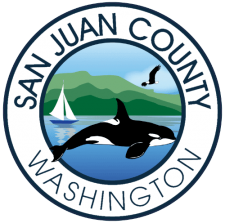HOT TOPIC #10: Medical Surge Planning: Hoping for the Best, Planning for the Worst
Posted April 1, 2020 at 5:30 am by Peggy Sue McRae
 COVID-19 updates from San Juan County around subjects on the minds of islanders
COVID-19 updates from San Juan County around subjects on the minds of islanders
Many in the islands are wondering how San Juan County is preparing in case access to mainland medical care becomes limited. This is known as medical surge, which the CDC defines as, “…the ability to provide adequate medical evaluation and care during events that exceed the limits of the normal medical infrastructure of an affected community.”
We’re hopeful, and maybe even a tiny bit optimistic that recent actions to require social distancing and other measures to slow the spread of this virus will help avoid the need to implement any medical surge plans. And if we can get expanded access to testing, that may also help us keep the COVID curve as flat as possible. But make no mistake, without continued active steps to minimize disease spread, the medical system we rely on for both local and advanced off-island care will be overwhelmed. So while it is our sincere hope that the islands won’t experience a worst-case scenario that limits our ability to transport patients to the mainland for advanced treatment, we are very much operating with a mindset of “hoping for the best and planning for the worst.”
Local health care providers, EMS agencies, and the County COVID-19 Response Team have been actively coordinating and have developed plans to provide basic medical services to islanders should the need arise. These plans are flexible, and ready to scale up or down as we learn more about specific needs and limitations in the weeks to come.
Local medical surge plans are designed to ensure appropriate allocation of limited resources such as personnel, personal protective equipment (PPE), facilities, medical supplies, and medications. Islanders need to keep in mind that there are critical ongoing shortages of key supplies on a national and global level, and that local limitations around staff, facilities, and equipment mean that in a worst case scenario, the high-quality advanced care that we have access to in normal times will likely not be available.
The following describes key elements in our planning efforts to respond to a medical surge:
- Hospital Capacity: We’re working collaboratively with our healthcare partners both locally and across Western Washington to ensure shared communication about mainland hospitals’ ability to receive patients and provide care. Our first choice will always be rapid transport to an advanced mainland hospital.
- Hospital Services: On San Juan Island, PeaceHealth Peace Island Medical Center has been actively working on a surge plan that enables them to treat those in need of hospital level care but who are unable to be transported to the mainland. Some details of that plan were shared in this press release and this more recent one as well.
- Clinic Services: On Orcas and Lopez, the Basic Care Facilities would be there to provide support to patients unable to be transported to a hospital, and care would be closely coordinated with the patient’s primary care physician.
- Basic Care Facilities in the Islands: The COVID-19 Response Team is actively finalizing plans for Basic Care Facilities on Orcas, Lopez, and San Juan. Basic Care Facilities are no substitute for a hospital, and will only be opened if and when the need should arise (again, we’re sincerely hoping that it won’t). These will be re-purposed facilities in our community equipped with basic levels of staffing and support to provide a basic level of feeding and care. On San Juan, PeaceHealth Peace Island would be the first choice for patient care if mainland transport is not an option, and the Basic Care Facility would be their support if need be once a patient is discharged from the medical center. On Orcas and Lopez, the Basic Care Facilities would be there to provide support to patients unable to be transported to a hospital, and care would be closely coordinated with the UW Medicine Clinics on each island.The overall goal is always to keep as many people in their homes as possible, but when a patient can no longer be cared for at home, the decision to move will be determined by the individual’s health care provider and if required, transportation will be coordinated with EMS.
In all scenarios, protection of staff, volunteers and patients will always be the top priority.
We recognize that the situation we’re in is an intimidating one. These are unusual times and this crisis is like no other. Please know that though San Juan County is one of the smallest counties in the state, we plan on fully utilizing all of the expertise, resources, and energy of the islands to get through this as quickly and safely as we possibly can. As we enter the second month of the fully activated response, it is only more clear that it will be the ongoing tireless efforts of our local healthcare community, our EMS and Fire first responders, the many citizen volunteers, our local government staff, our business community, and so many others that sees us through. Stay safe.
You can support the San Juan Update by doing business with our loyal advertisers, and by making a one-time contribution or a recurring donation.
Categories: Community, Health & Wellness










No comments yet. Be the first!
By submitting a comment you grant the San Juan Update a perpetual license to reproduce your words and name/web site in attribution. Inappropriate, irrelevant and contentious comments may not be published at an admin's discretion. Your email is used for verification purposes only, it will never be shared.